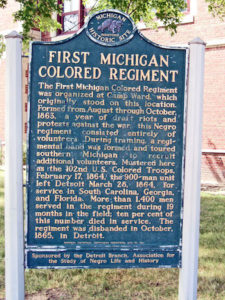
*On this date in 1863, the First Michigan Colored Regiment was organized.
Raised at Camp Ward, MI., these troops were paid no bounty and received ten dollars monthly, one ration per day. Also, three dollars of monthly pay was deducted for clothing, and white officers commanded the troops. Under this order, the Regiment was known originally as the First Regiment of Colored Infantry. After its designation changed to the 102nd. United States Colored Troops commenced on August 12th, 1863, with 895 men.
The Regiment left its rendezvous at Detroit on March 28th, 1864, under the command of Colonel Bennett, joining the 9th. Army Corp at Annapolis, MD, remaining at that place until April 15th when they left on steamers for Hilton Head, S.C. Detachments of the Regiment were employed on picket duty on St. Helena and Jenkin's Islands, then at Sea Wall and Spanish Wells, on Hilton Head, for one month. They were then ordered to the fort at Port Royal and assigned to build fortifications and construct a second line of defenses. On June 15th, they moved to Beaufort, on Port Royal Island, employed as a camp guard and provost duty until the end of August before leaving for Jacksonville, Florida.
On August 4, 1864, they marched to Baldwin, a railroad junction 21 miles from Jacksonville, for picket duty, also destroying tracks there. On August 11th, a force of Confederate Cavalry, which they fought off, attacked them. Their action fully convinced their officers they were a most reliable and gallant fighting Regiment. Leaving Baldwin on the 15th, the Regiment moved through Eastern Florida, making a circuit of nearly one hundred miles in 5 days, reaching the St. Johns River at Magnolia, thirty-five miles above Jacksonville. At Magnolia, they built fortifications while performing other garrison duties. The Regiment reached Beaufort on August 31st.
On September 1, they were sent to the front to do picket duty, where they engaged Confederates at different points on Coosa, Lady's, and Port Royal Islands. In October, the Confederates tried to land a surprise force under the cover of darkness to attack the Regiment on duty at Lady's Island but were discovered when and driven off. On November 30th, a detachment of the Regiment, consisting of 12 officers and 300 men, left Beaufort, joining General Foster's column at Boyd's Landing, being engaged with the Confederates at Honey Hill, S.C., Tillifinny, and Devaux Neck. There, they performed gallantly in the face of a vastly superior force sustaining in the three engagements 65 killed and wounded. On January 19, 1865, they returned to Beaufort and then set out for Pocotalligo, remaining until February 7th.
The First Michigan Colored Regiment then crossed the Salkehatchie River to Charleston. They did a reconnaissance to Cuckold Creek, where Confederate skirmishers were met, driving them from the area. On March 9th, the Regiment boarded steamers for Savannah, GA, where they remained striking the Southern works at Nelson's Ferry. On March 18th, near Manchester, GA. Along with the 54th. Massachusetts infantry flanked Confederates, driving them in great disorder in the direction of Statesburg. The Regiment remained in that general area until the Confederates approached them under a flag of truce with a dispatch that Generals Robert E. Lee and Johnston had surrendered, and the war was over. The Regiment stayed at their post until April 25th; they marched to and stayed at Charleston until September 30th.
The First Michigan Colored Regiment was mustered out, proceeding to Michigan, arriving in Detroit on October 17th, 1865, to be paid off and disbanded. Over 1,400 men served in the regiment during 19 months in the field; ten percent died in service.